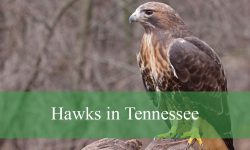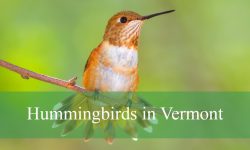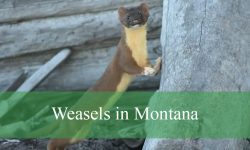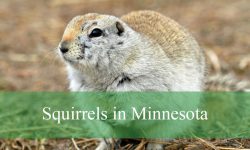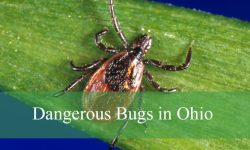If you ever have the chance to visit Massachusetts, prepare to be amazed by the incredible variety of birds that call this state home. From vibrant songbirds to majestic raptors and charming waterfowl, the diversity of birds in Massachusetts is truly impressive. For both experienced birders and beginners, this state offers countless opportunities to observe fascinating feathered species in their natural habitats.
Exploring the forests, wetlands, coastal shores, and urban parks of Massachusetts reveals an extraordinary birdwatching experience unlike any other. The birds in Massachusetts include both year-round residents and seasonal visitors, each adding unique colors, songs, and behaviors to the rich tapestry of wildlife. This guide introduces 46 remarkable species you can spot across the state, complete with pictures and tips for identification.
Hiking a wooded trail or strolling along a sandy beach, Massachusetts invites you to discover the beauty and wonder of its avian inhabitants. Get ready to dive into the world of these fascinating birds and learn how to recognize them on your next outdoor adventure in the Bay State.
Common Birds Found in Massachusetts
Black-capped Chickadee (state bird of Massachusetts)

The Black-capped Chickadee is a small, charming songbird famous for its distinctive black cap and bib contrasting with white cheeks. It measures only about 4.7 to 5.9 inches (12 to 15 cm) in length with a wingspan around 6 to 8 inches (16 to 20 cm). Its soft gray body and buffy sides help it blend into wooded environments, but its bold black and white head pattern is unmistakable.
This chickadee is best known for its clear and recognizable “chick-a-dee-dee-dee” call, which varies in complexity depending on the situation. It also sings a high-pitched, whistled “fee-bee” or “hey, sweetie” song. Behaviorally, the Black-capped Chickadee is highly social and curious, often seen flitting actively through trees and shrubs. They forage for insects, seeds, and berries, frequently visiting bird feeders in winter.
As the state bird of Massachusetts, the Black-capped Chickadee is abundant across the region. It inhabits deciduous and mixed forests, woodlands, and suburban areas with ample trees and shrubs. This species remains in Massachusetts year-round, enduring cold winters by storing food and seeking shelter in tree cavities or nest boxes.
American Robin
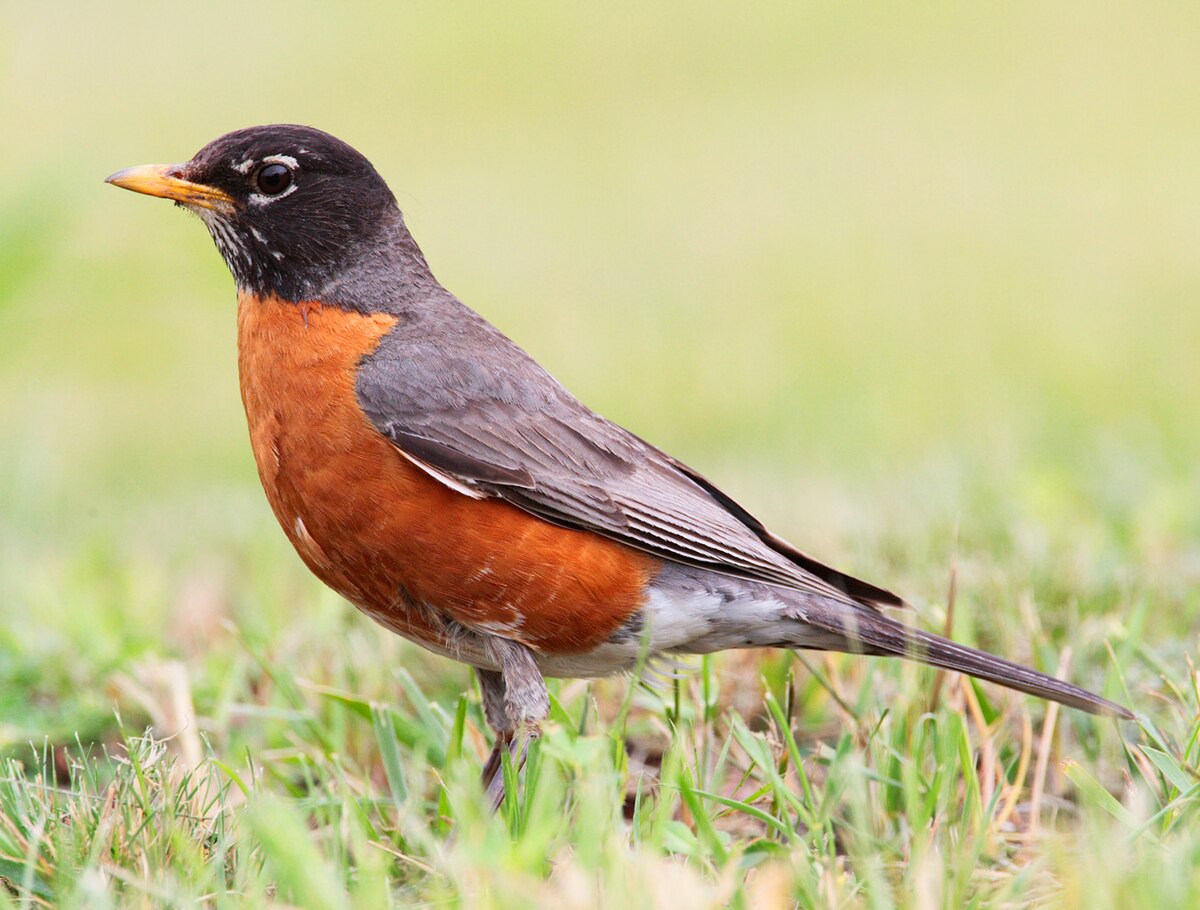
The American Robin is a medium-sized songbird widely recognized by its bright orange-red breast and grayish-brown back. Adult robins typically measure about 9 to 11 inches (23 to 28 cm) in length with a wingspan of 12 to 16 inches (31 to 41 cm). They have a white throat streaked with black and a yellow beak that helps distinguish them from similar species. Their rounded body and upright posture give them a distinctive silhouette.
Robins are known for their melodious and clear song, often described as a series of cheery whistles. Their vocalizations include a variety of calls used for communication, including a sharp “tut-tut” alarm call. Behaviorally, they are often seen foraging on lawns and open areas, hopping along the ground in search of earthworms and insects. They are also opportunistic feeders, enjoying berries and fruits during colder months.
In Massachusetts, the American Robin is one of the most common and beloved birds, frequently spotted in suburban yards, parks, and forests. They are migratory in this region, typically arriving in early spring and leaving in late fall. Robins prefer open woodlands, gardens, and grassy fields where food is abundant, thriving throughout the state from coastal areas to inland forests.
Northern Cardinal

The Northern Cardinal is a striking bird noted for the brilliant red plumage of the male, while females display warm tan feathers with reddish tinges on wings and tail. Measuring around 8 to 9 inches (20 to 23 cm) in length, with a wingspan near 10 to 12 inches (25 to 31 cm), the cardinal has a distinctive crest on its head and a strong, cone-shaped red bill. This bird’s bold colors and unique shape make it one of the most easily identifiable species in Massachusetts.
Their song is rich and melodic, consisting of clear whistles and varied phrases often described as “cheer, cheer, cheer” or “birdie, birdie, birdie.” Cardinals are territorial year-round and known for their bold, confident behavior. They frequently visit backyard feeders and can be observed feeding on seeds, fruits, and insects. Cardinals tend to perch openly on branches or fence posts, making them highly visible.
In Massachusetts, the Northern Cardinal is a year-round resident, inhabiting dense shrubs, wood edges, and residential areas. They adapt well to suburban environments, often found in gardens and wooded parks. Their presence is widespread throughout the state, from rural to urban areas, making them a favorite among bird watchers and nature lovers.
Blue Jay
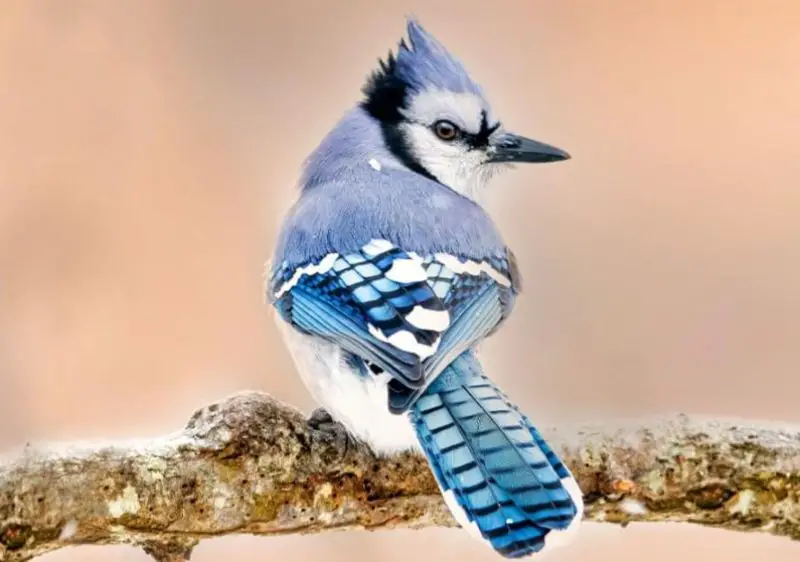
The Blue Jay is a vibrant bird with bright blue upperparts, white underparts, and striking black markings around the neck and face. It measures about 9 to 12 inches (23 to 30 cm) long, with a wingspan of 13 to 17 inches (34 to 43 cm). The prominent crest on its head and loud calls make it easy to identify. The pattern of blue, black, and white feathers creates a beautiful contrast, especially visible in flight.
Blue Jays are known for their loud and varied vocalizations, which include harsh “jay” calls, whistles, and mimicry of other birds such as hawks. Their behavior is bold and intelligent; they often forage both on the ground and in trees, feeding on nuts, seeds, insects, and occasionally small vertebrates. Blue Jays are also known for their caching behavior, storing food for later use.
In Massachusetts, Blue Jays are common year-round residents, inhabiting forests, woodlots, and suburban areas. They prefer mixed deciduous and coniferous forests but are highly adaptable to urban parks and backyards. Their loud calls and striking coloration make them one of the most recognizable birds throughout the state, frequently spotted and heard from spring through winter.
Tufted Titmouse
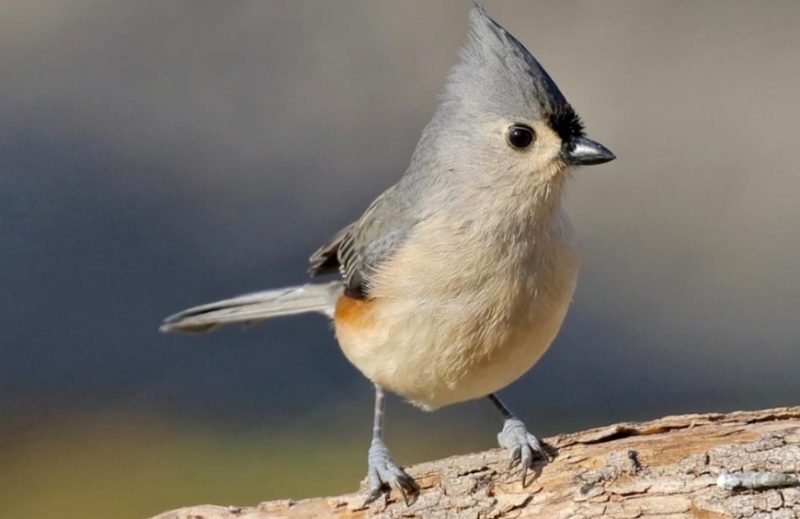
The Tufted Titmouse is a small, sturdy bird with a distinctive crest atop its head and large black eyes. Adults measure about 5.5 to 6.3 inches (14 to 16 cm) in length and have a wingspan near 7.9 to 10.2 inches (20 to 26 cm). Their soft gray upperparts contrast with white underparts and rusty flanks. The prominent crest and bold facial markings make the Tufted Titmouse easy to spot.
Their song consists of clear, whistled notes often described as “peter-peter-peter” repeated in a rapid series. They communicate with various calls, including a sharp “tssee” alarm note. Tufted Titmice are active, inquisitive birds that forage in mixed flocks, searching for insects, seeds, and nuts. They are known for hanging upside down on branches and visiting feeders.
In Massachusetts, the Tufted Titmouse is a common resident throughout wooded habitats, including deciduous forests, parks, and residential areas with mature trees. While more common in southern New England, its range has expanded northward in recent decades. They nest in tree cavities or nest boxes and are a favorite among backyard bird watchers across the state.
House Finch
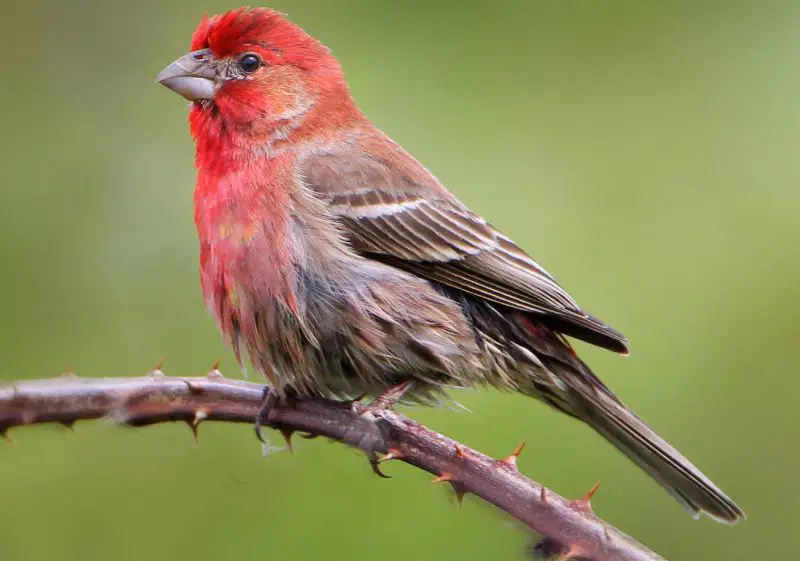
The House Finch is a small songbird measuring about 5 to 6 inches (13 to 15 cm) in length with a wingspan of approximately 8 to 10 inches (20 to 25 cm). Males display a bright red head, throat, and chest that can sometimes appear orange or yellow, while females are brown and streaked with a more subdued coloration. Their conical beak is well adapted for cracking seeds, making them common visitors at feeders. Their overall appearance is somewhat streaky with a short, notched tail.
House Finches have a cheerful, warbling song composed of a series of short, sweet phrases often described as a “cheer-up, cheerily” sound. They are very social and active birds, frequently seen in flocks especially outside the breeding season. Their behavior includes hopping on branches or perching conspicuously on wires and rooftops. House Finches feed mainly on seeds, fruits, and occasional insects, showing great adaptability to urban and suburban settings.
In Massachusetts, House Finches are common year-round residents, especially in cities, suburbs, and open woodland edges. Originally native to the western U.S., they were introduced to the East Coast and have since thrived in urban habitats. They build nests in a variety of locations such as trees, shrubs, and even on building ledges. Their adaptability to human environments makes them one of the most widespread finches in the state.
Baltimore Oriole (Summer Visitor)

The Baltimore Oriole is a striking medium-sized songbird measuring about 6.7 to 7.5 inches (17 to 19 cm) long with a wingspan of 9 to 12 inches (23 to 30 cm). Males are brilliantly colored with a vivid orange belly and breast, black head, back, and wings with white wing bars. Females are more muted with yellow-orange underparts and grayish heads. The pointed bill is perfect for extracting insects and nectar from flowers. Their bright coloration makes them one of the most eye-catching birds in Massachusetts during summer.
Baltimore Orioles have a melodious, flute-like song with a series of clear, rich whistles and buzzy notes. Their vocalizations are often heard during the breeding season as males defend their territory. Behaviorally, they are active and agile, often seen foraging high in deciduous trees, feeding on insects, fruit, and nectar. They are also known for their intricate hanging basket nests woven from fibers, usually suspended from slender tree branches.
In Massachusetts, Baltimore Orioles are primarily summer residents, arriving in late April or early May and departing by late summer or early fall. They favor open woodlands, forest edges, parks, and suburban areas with large deciduous trees. Because of their striking appearance and beautiful song, they are a favorite of bird watchers during the warm months.
Eastern Bluebird
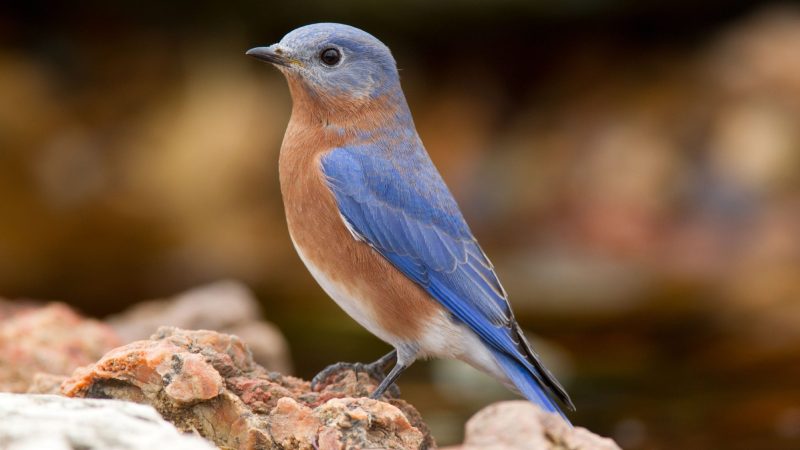
The Eastern Bluebird is a small thrush measuring around 6.3 to 8.3 inches (16 to 21 cm) in length with a wingspan of 9.8 to 12.6 inches (25 to 32 cm). Males display vibrant blue upperparts with a rusty orange throat and chest, while females are duller with grayish-blue wings and tail and paler underparts. Their slender body and round head with a short, straight bill are distinctive traits. Eastern Bluebirds are often seen perched on fence posts and wires scanning for prey.
Their song is a soft, melodious warble often described as a gentle “cheer, cheerful, cheer up” call. Eastern Bluebirds are primarily insectivorous during the breeding season, feeding on beetles, caterpillars, and grasshoppers but will also consume berries in colder months. They exhibit territorial behavior and nest in cavities, often in nest boxes provided by humans. They are known for their graceful flight and calm demeanor.
In Massachusetts, Eastern Bluebirds are found mostly during spring and summer when they breed in open fields, meadows, orchards, and suburban areas with scattered trees. They prefer habitats with ample perches and open ground for foraging. Conservation efforts, including widespread nest box programs, have helped their populations rebound in recent decades, making them a welcomed sight in the state.
Various Warblers (Especially During Migration)
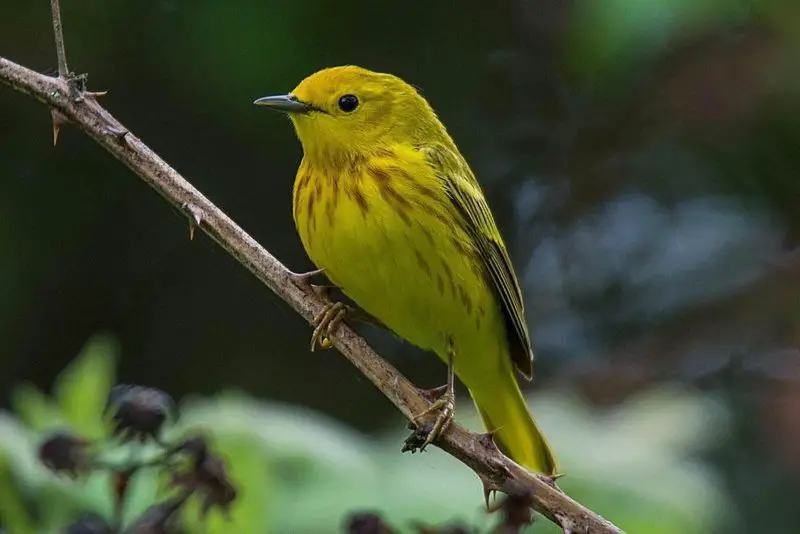
Warblers in Massachusetts encompass many species of small, colorful songbirds that are especially notable during spring and fall migration. These birds generally measure between 4 to 6 inches (10 to 15 cm) in length and often display vibrant plumage with combinations of yellow, green, black, white, and blue, depending on the species. They are slender, agile birds with fine pointed bills adapted to gleaning insects from foliage.
Warblers are known for their complex and varied songs, which can include rapid trills, buzzy notes, and melodious whistles. They are highly active, constantly flitting through tree branches and shrubs as they forage for insects and spiders. Many warblers are migratory, traveling long distances between breeding grounds in Massachusetts and wintering areas in Central and South America. Their behavior often involves quick movements, vocal calls to maintain contact, and territorial displays during breeding season.
In Massachusetts, warblers appear mainly during migration seasons, with some species breeding in the state’s forests and woodlands. Popular species include the Black-throated Blue Warbler, Yellow-rumped Warbler, and Common Yellowthroat. They favor diverse habitats such as deciduous and mixed forests, shrubby wetlands, and parklands. For bird watchers, the arrival of warblers marks a spectacular time of year filled with colorful and vocal bird activity.
Red-tailed Hawk
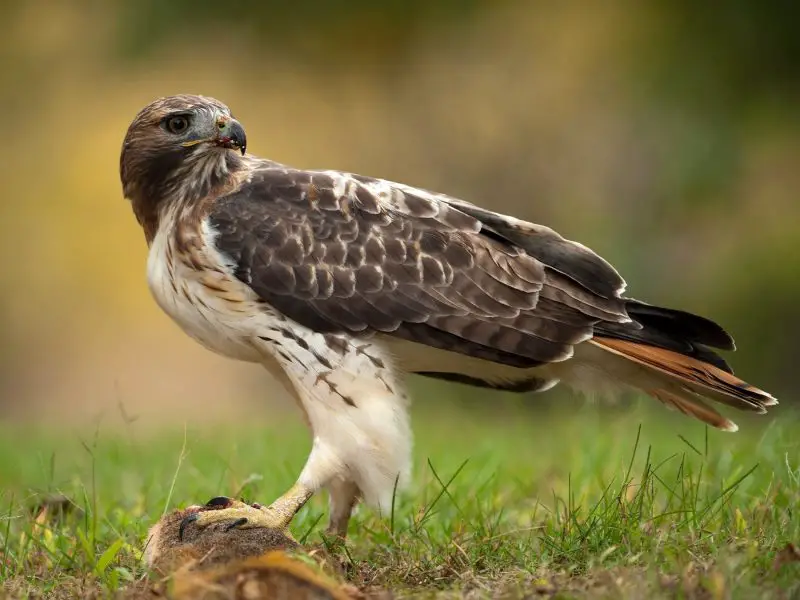
The Red-tailed Hawk is a large and robust raptor measuring about 18 to 26 inches (46 to 66 cm) in length with a wingspan ranging from 43 to 56 inches (110 to 140 cm). It is easily recognized by its reddish-brown tail, broad wings, and stocky build. The bird’s back and upper wings are brown, while the chest is pale with a streaked belly band. Juveniles lack the red tail, having instead a brown and barred tail pattern.
This hawk’s call is a distinctive, loud, and piercing “kee-eeeee-ar” scream often used in movies to represent any bird of prey. Behaviorally, Red-tailed Hawks are powerful hunters that soar high on thermal currents, scanning open fields, roadsides, and woodland edges for rodents, rabbits, and snakes. They are known for their keen eyesight and strong talons, enabling them to capture a variety of prey on the ground or in flight.
In Massachusetts, Red-tailed Hawks are common year-round residents, inhabiting a wide range of environments including forests, farmlands, suburban areas, and coastal cliffs. They prefer open or semi-open habitats where they can easily spot prey. Their adaptability to human-altered landscapes has made them one of the most widespread raptors in the state, frequently seen perched along highways or soaring overhead.
Cooper’s Hawk
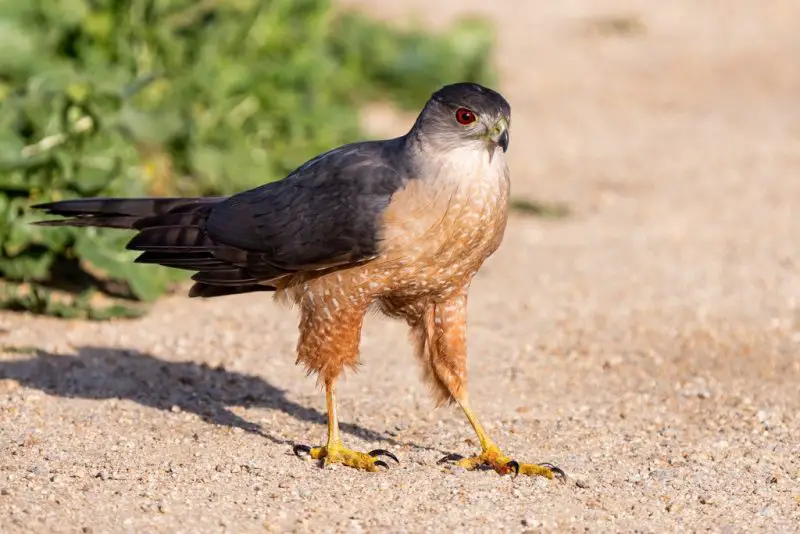
The Cooper’s Hawk is a medium-sized hawk measuring 14 to 20 inches (35 to 50 cm) in length with a wingspan of about 24 to 35 inches (62 to 90 cm). It has a rounded tail with dark bands and a slate-gray back and wings, while its chest is white to light brown with fine reddish barring. The eyes are typically bright yellow in juveniles and turn deep red as they mature. Its slim profile and long tail help distinguish it from similar species.
Cooper’s Hawks have a high-pitched, rapid “cak-cak-cak” call that is often heard during the breeding season. They are agile hunters, known for their speed and maneuverability through dense trees while chasing birds and small mammals. They frequently hunt in wooded habitats and suburban areas, relying on surprise and quick strikes to capture prey like pigeons, doves, and songbirds.
In Massachusetts, Cooper’s Hawks are common year-round residents, especially in mature forests and urban parks where bird populations are abundant. They are increasingly adapting to suburban environments and often nest in large trees near human habitation. Their presence in Massachusetts contributes to controlling populations of smaller birds and rodents.
Sharp-shinned Hawk
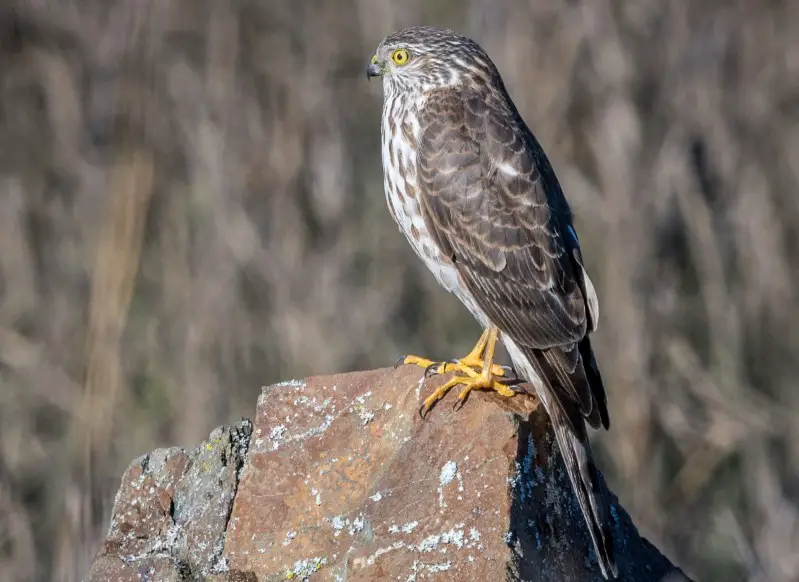
The Sharp-shinned Hawk is the smallest hawk in Massachusetts, measuring approximately 9 to 13 inches (23 to 33 cm) in length with a wingspan of 17 to 24 inches (43 to 61 cm). It has a short, square-tipped tail with several narrow dark bands and a blue-gray back with rusty barring on the chest. Its small size and rapid, flap-flap-glide flight pattern help distinguish it from similar hawks like the Cooper’s Hawk.
Its call is a high-pitched, thin “kik-kik-kik” or “chip-chip-chip,” often heard during migration and breeding seasons. Sharp-shinned Hawks are stealthy and quick predators that hunt small birds, such as sparrows and finches, darting through dense vegetation with remarkable agility. They usually hunt close to the ground or within thick forested areas, making use of surprise attacks.
In Massachusetts, Sharp-shinned Hawks are found primarily during migration but some remain year-round in forested areas. They favor mature deciduous and mixed woodlands, often near water bodies. Their elusive nature makes them less commonly seen than other hawks, but bird watchers often spot them during fall and spring migration periods.
Osprey (near rivers and coastlines)
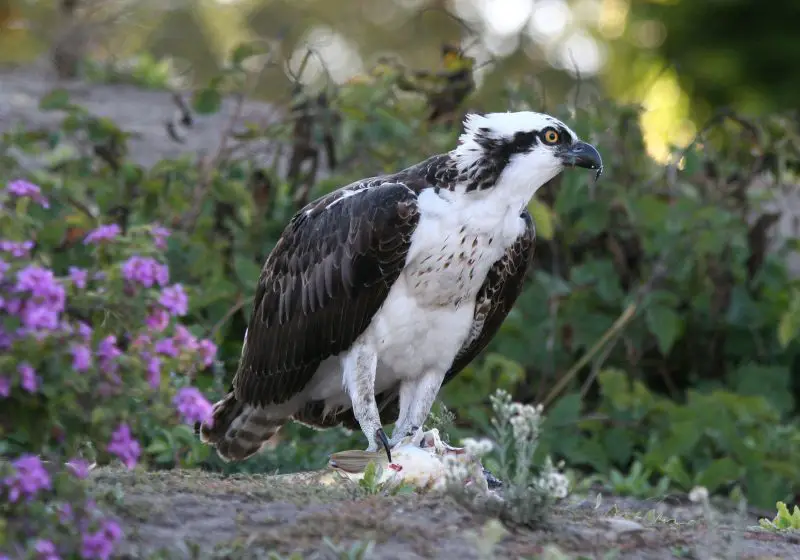
The Osprey is a large raptor measuring about 21 to 26 inches (53 to 66 cm) in length with a wingspan of 59 to 71 inches (150 to 180 cm). It has a distinctive white head with a dark eye stripe and a white underbelly contrasting sharply with dark brown upperparts. Its long, narrow wings are angled in flight, giving it a unique silhouette often described as “M-shaped.” The powerful hooked beak is adapted for fishing.
Ospreys produce a series of high-pitched whistles and chirps, especially near nesting sites. They are specialist fish hunters, diving feet-first into water to catch prey with their sharp talons. Ospreys often hover or soar over water bodies scanning for fish, then plunge spectacularly to seize them. They are highly migratory, moving south in the winter and returning to breed in Massachusetts in spring.
In Massachusetts, Ospreys are mostly found near rivers, lakes, estuaries, and coastal areas where fish are abundant. They build large nests on man-made platforms, dead trees, or utility poles close to water. Their populations have recovered significantly due to conservation efforts, making them a spectacular sight during the breeding season from late spring through summer.
Bald Eagle
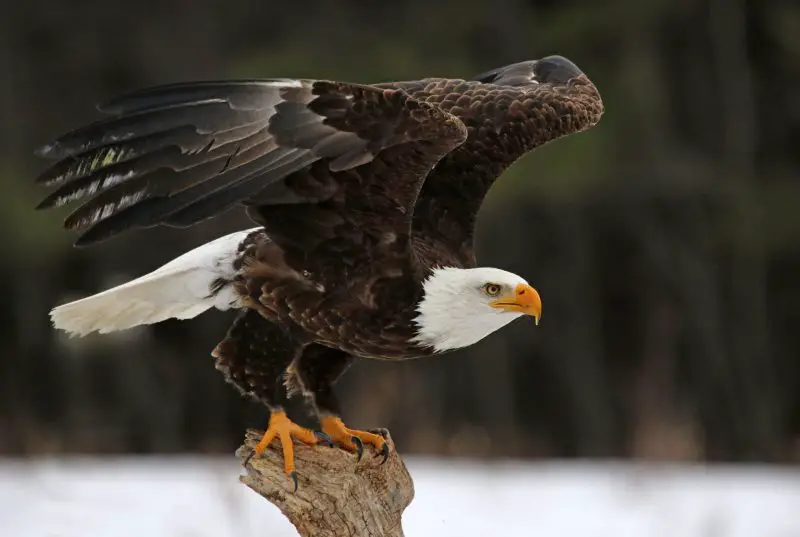
The Bald Eagle is an impressive raptor and the national bird of the United States, measuring about 28 to 40 inches (71 to 102 cm) in length with a wingspan of 71 to 90 inches (180 to 230 cm). Adults have a striking white head and tail contrasting with dark brown body and wings, while juveniles are mostly mottled brown and white until maturity around 4-5 years old. Their powerful yellow beak and large talons make them formidable hunters.
Bald Eagles produce a series of high-pitched, whistling calls that can sound quite harsh, especially near nests. They are skilled fish hunters, often seen soaring over rivers and lakes, using their sharp eyesight to spot prey from great heights. Bald Eagles are known for their majestic soaring flight and strong territorial behavior during breeding season, building massive nests usually in tall trees near water.
In Massachusetts, Bald Eagles are primarily found near large bodies of water such as reservoirs, rivers, and coastal areas where fish are plentiful. After significant declines mid-20th century, their populations have rebounded due to conservation efforts and legal protections. Today, they are seen year-round, with breeding pairs commonly nesting in forested wetlands and protected areas across the state.
Barred Owl
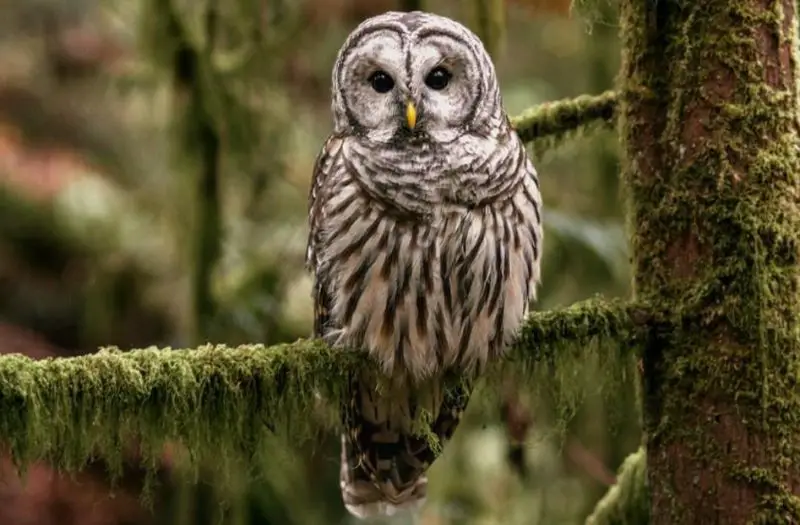
The Barred Owl is a medium to large owl measuring 16 to 25 inches (40 to 63 cm) in length with a wingspan of about 38 to 49 inches (96 to 125 cm). It has a rounded head without ear tufts and dark brown eyes, which distinguish it from other owls with yellow eyes. The plumage is mottled brown and white with horizontal bars on the chest and vertical streaks on the belly, giving it its name.
Its distinctive call sounds like “Who cooks for you? Who cooks for you-all?” repeated in a series of hoots. Barred Owls are primarily nocturnal but can be active at dusk and dawn. They hunt small mammals, birds, reptiles, and amphibians, often by silently swooping through dense forests. They prefer mature forests near water sources such as swamps, rivers, and lakes.
In Massachusetts, Barred Owls are year-round residents commonly found in wooded areas, especially in mature deciduous or mixed forests. Their adaptability to various forested habitats, including suburban woodlots, makes them relatively common. They nest in tree cavities or abandoned nests and are often heard during the breeding season in spring.
Great Horned Owl
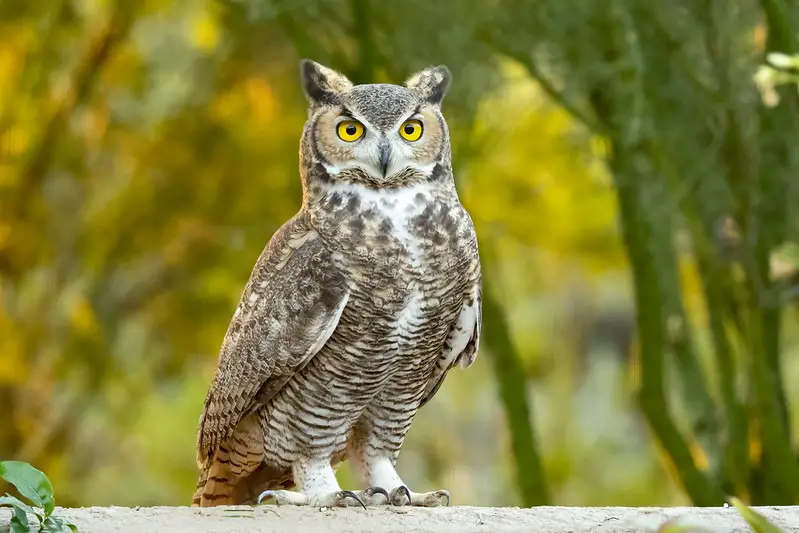
The Great Horned Owl is a large and powerful owl, measuring 18 to 25 inches (46 to 64 cm) in length with a wingspan of 40 to 57 inches (101 to 145 cm). It is named for its prominent ear tufts or “horns,” which are actually feather tufts. The plumage is mottled brown and gray with a barred pattern on the chest and belly. Its deep yellow eyes and large size make it a formidable predator.
This owl’s call is a series of deep, resonant hoots typically given in a pattern of five to eight notes, often described as “hoo-hoo hoo hoo hoo.” Great Horned Owls are nocturnal hunters with a diverse diet including mammals, birds, reptiles, and insects. They are adaptable, inhabiting forests, swamps, deserts, and even urban areas. Their powerful talons allow them to prey on animals larger than themselves.
In Massachusetts, Great Horned Owls are widespread year-round residents found in various habitats such as woodlands, farmlands, and suburban areas with large trees. They often nest in abandoned nests of other large birds or natural tree cavities. Their booming calls can frequently be heard during the breeding season in late winter to early spring.
Eastern Screech Owl
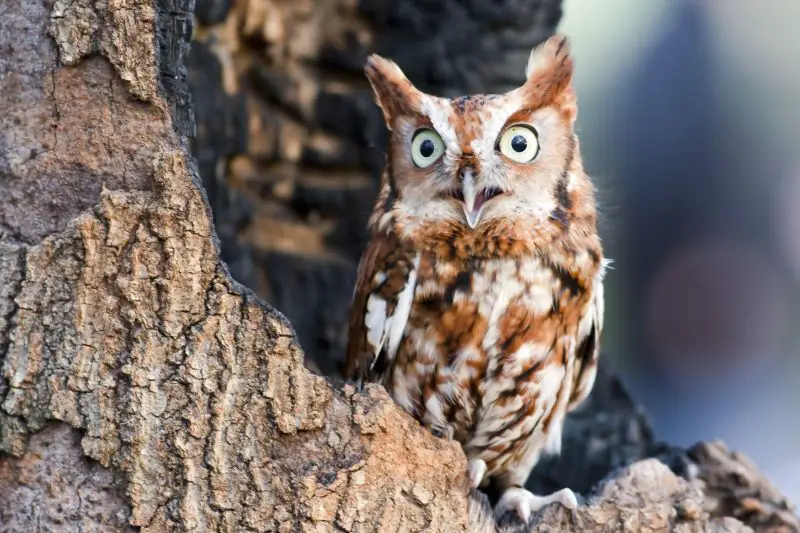
The Eastern Screech Owl is a small, compact owl measuring about 6 to 10 inches (16 to 25 cm) in length with a wingspan of 18 to 24 inches (46 to 61 cm). It has distinctive ear tufts and comes in two color morphs: gray and reddish-brown. The plumage is intricately patterned with streaks and mottling, providing excellent camouflage against tree bark. Its yellow eyes and small size make it discreet but alert.
Its vocalizations include a variety of trills, whistles, and tremolo calls, often described as a descending whinny or a soft, repetitive “bouncing ball” trill. Eastern Screech Owls are primarily nocturnal and highly territorial. They hunt insects, small mammals, and birds, often hunting from perches near woodland edges or suburban areas. They nest in natural cavities or nest boxes.
In Massachusetts, Eastern Screech Owls are year-round residents commonly found in deciduous and mixed forests, parks, and suburban woodlands. They adapt well to human presence, often roosting in tree cavities near homes. Their elusive nature and camouflaged plumage make them less frequently seen, but their calls are a familiar sound on spring and summer nights.
Mallard Duck

The Mallard Duck is a medium-sized dabbling duck measuring about 20 to 26 inches (50 to 65 cm) in length with a wingspan of 32 to 39 inches (81 to 99 cm). Males are easily recognized by their iridescent green heads, white neck rings, chestnut-brown chests, and gray bodies, while females have mottled brown plumage that provides excellent camouflage. Both sexes have bright orange legs and a distinctive blue speculum bordered by white on their wings.
Mallards produce a variety of vocalizations, with the male’s quack being softer and raspier, while females have a louder, more familiar “quack” often heard near water bodies. They are highly adaptable and opportunistic feeders, dabbling at the water surface or tipping forward to forage underwater for aquatic plants, insects, and small fish. Their behavior includes forming large flocks during migration and often pairing for life during the breeding season.
In Massachusetts, Mallards are common year-round residents found in wetlands, ponds, rivers, and urban parks with water. They breed in marshes and grassy areas near water and migrate locally or to southern states in harsher winters. Their adaptability to human-modified environments makes them one of the most frequently seen ducks throughout the state.
Canada Goose

The Canada Goose is a large waterfowl species measuring 30 to 43 inches (75 to 110 cm) in length with a wingspan of 50 to 71 inches (127 to 180 cm). It has a distinctive black head and neck with a prominent white chinstrap, brown body, and pale underbelly. Canada Geese are strong, long-distance migrators and are easily identified by their honking calls during flight and on the ground.
Their vocalizations are loud, honking sounds used for communication within flocks, especially during migration and territorial defense. Canada Geese feed primarily on grasses, grains, and aquatic vegetation, often grazing in open fields and lawns near water bodies. They are social birds, forming large flocks during migration and winter, and can be aggressive when defending nesting territories.
In Massachusetts, Canada Geese are both migratory and resident birds, commonly seen in lakes, ponds, rivers, and urban green spaces. Their populations have grown significantly, sometimes causing conflicts in suburban and urban areas. They nest near water in tall grasses or on islands, with breeding season occurring in spring.
Wood Duck
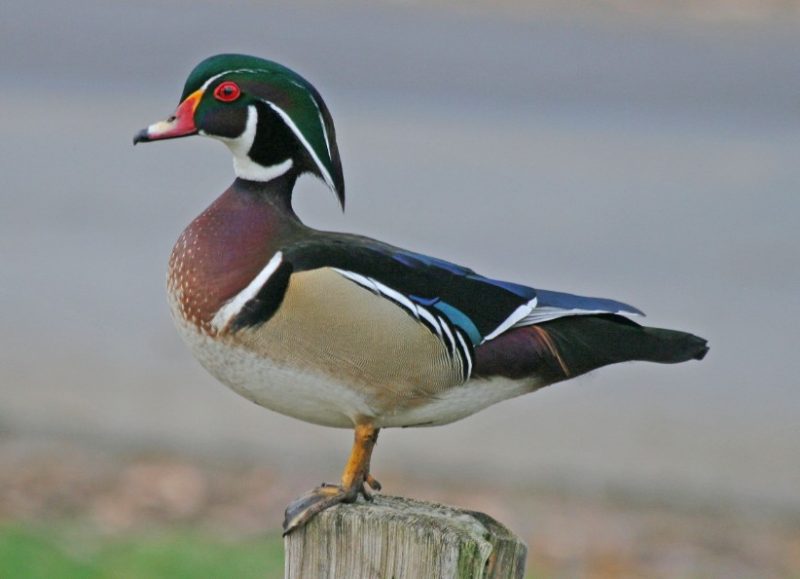
The Wood Duck is a strikingly colorful medium-sized duck, measuring about 16 to 21 inches (41 to 54 cm) long with a wingspan of 26 to 29 inches (66 to 73 cm). Males have iridescent green and purple heads with distinctive crests, red eyes, and a white throat bordered by black stripes. Females are more subdued with gray-brown bodies and white eye rings. Their ornate plumage makes them one of the most beautiful ducks in North America.
Wood Ducks produce soft whistles and trills, with males often giving rising whistles and females emitting a high-pitched “oo-eek” call. They prefer wooded wetlands, nesting in tree cavities near water, and are excellent climbers, sometimes seen perching in trees. Their diet consists of seeds, fruits, insects, and aquatic plants, and they are known for their agility in flight and ability to navigate dense forests.
In Massachusetts, Wood Ducks breed primarily in wooded swamps, ponds, and river edges during spring and summer. They are migratory but may overwinter in milder coastal areas. Conservation efforts have helped their populations recover, and nest boxes are commonly used to support breeding success.
Great Blue Heron
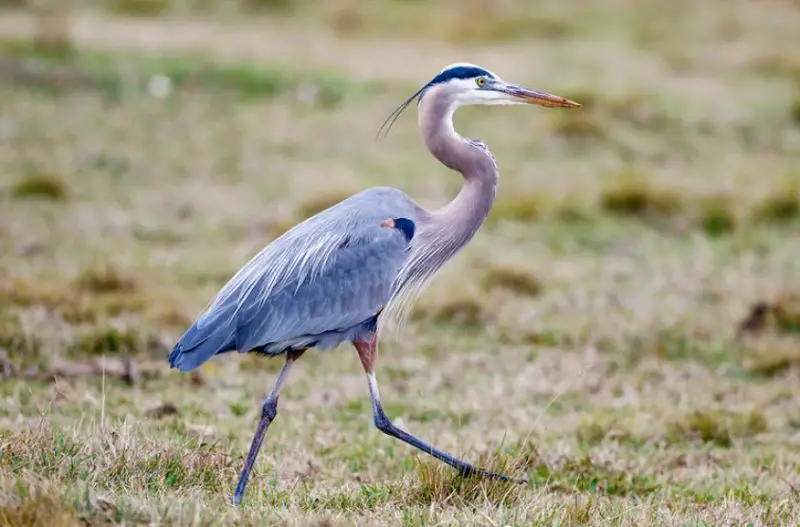
The Great Blue Heron is a large, elegant wading bird measuring about 38 to 54 inches (97 to 137 cm) tall with a wingspan of 66 to 79 inches (168 to 200 cm). It has a slate-blue body with a white face and black stripe above the eye extending to slender plumes on the head. Its long neck and legs, coupled with a sharp yellow bill, give it a distinctive silhouette.
Great Blue Herons produce low, harsh croaks and squawks, often heard near their rookeries. They are patient hunters, standing still or slowly stalking fish, amphibians, and small mammals in shallow waters. Their feeding behavior involves quick thrusts of their long bills to capture prey. They often nest in colonies high in trees near water and return to the same sites annually.
In Massachusetts, Great Blue Herons are common year-round, frequenting freshwater wetlands, ponds, lakes, rivers, and coastal estuaries. They breed in large communal rookeries located in forested wetlands. Their presence is a good indicator of healthy aquatic ecosystems, and they are a favorite among bird watchers for their graceful appearance.
Snowy Egret
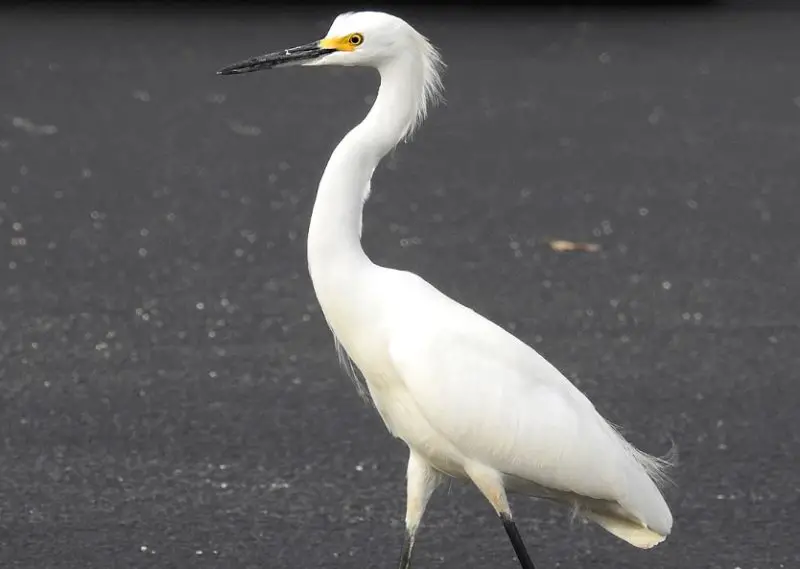
The Snowy Egret is a medium-sized white heron measuring about 22 to 26 inches (56 to 66 cm) in length with a wingspan of 39 to 41 inches (99 to 105 cm). It is easily recognizable by its pure white plumage, slender black legs, and bright yellow feet, which are often seen stirring the water while foraging. During the breeding season, elegant wispy plumes appear on its head, neck, and back.
Snowy Egrets have a variety of soft calls including low croaks and sharp whistles, though they are generally quieter than many other waterbirds. Their behavior is characterized by active foraging in shallow waters, where they use their bright yellow feet to stir up prey such as small fish, crustaceans, and insects. They are agile and graceful hunters, often seen walking slowly or standing still in marshes and tidal flats.
In Massachusetts, Snowy Egrets are primarily summer visitors found along coastal marshes, estuaries, and tidal pools. They are migratory and usually arrive in late spring, departing by early fall. Conservation efforts have helped their populations recover from historic declines, making them a cherished sight during the warmer months.
Double-crested Cormorant

The Double-crested Cormorant is a large waterbird measuring about 28 to 35 inches (71 to 89 cm) long with a wingspan of 45 to 50 inches (114 to 127 cm). It has dark, glossy black feathers with a slightly hooked bill and striking orange-yellow throat patch. During breeding season, it develops tufts of double crests on the head, which give the species its name.
Cormorants are known for their distinctive guttural croaking calls heard near nesting colonies. Their behavior includes excellent diving and swimming abilities as they chase fish underwater, using their webbed feet for propulsion. After fishing, they are often seen perched with wings spread wide to dry their feathers, since their plumage is less waterproof than other waterbirds.
In Massachusetts, Double-crested Cormorants are common summer residents along coastal bays, lakes, and rivers. They nest in large colonies on rocky islands, trees, or man-made structures near water. Their populations have increased in recent decades, sometimes leading to conflicts with fisheries and conservation concerns in localized areas.
Mute Swan

The Mute Swan is a large and elegant waterfowl species measuring 50 to 60 inches (127 to 152 cm) in length with a wingspan of 79 to 94 inches (200 to 240 cm). It has all-white plumage, an orange bill with a distinctive black knob at the base, and a long, curved neck. Despite its name, the Mute Swan is not silent but less vocal than other swans, often producing soft hissing or grunting sounds.
Mute Swans display graceful swimming and feeding behavior, often seen dipping their heads underwater to forage on aquatic vegetation. They are territorial, especially during breeding season, aggressively defending their nests and young from intruders. These swans are known to form lifelong pairs and build large nests near shallow water bodies.
In Massachusetts, Mute Swans are non-native but have established stable populations in lakes, ponds, and slow-moving rivers. Introduced in the 19th century for ornamental purposes, they have become common in both urban parks and rural wetlands. While admired for their beauty, they sometimes compete with native waterfowl for resources.
Herring Gull

The Herring Gull is a large gull species measuring about 23 to 26 inches (58 to 66 cm) in length with a wingspan of 54 to 57 inches (137 to 145 cm). Adults have a light gray back and wings, white head and underparts, yellow legs, and a thick yellow bill with a distinctive red spot on the lower mandible. Juveniles are mottled brown and gradually acquire adult plumage over several years.
Herring Gulls are noisy birds with a wide variety of calls including loud squawks and rattles. They are opportunistic feeders and highly adaptable, often scavenging near coastal areas, garbage dumps, and urban environments. Their diet includes fish, invertebrates, small birds, and human food waste. Behaviorally, they are bold and social, often seen in large flocks resting on beaches, docks, and rooftops.
In Massachusetts, Herring Gulls are common year-round along the coast and inland water bodies. They breed on rocky islands and cliffs, and their presence is especially noticeable in harbor towns and coastal cities. Their adaptability has allowed their populations to thrive despite changes in the environment and human activity.
Ring-billed Gull

The Ring-billed Gull is a medium-sized gull measuring about 17 to 21 inches (43 to 53 cm) in length with a wingspan of 41 to 46 inches (105 to 117 cm). Adults have a white head and underparts, light gray wings and back, yellow legs, and a slender yellow bill with a distinct black ring near the tip. Juveniles display mottled brown plumage before maturing.
This gull has a high-pitched, laughing call often heard near shorelines and inland lakes. Ring-billed Gulls are opportunistic feeders, consuming fish, insects, small mammals, and human refuse. They are frequently seen scavenging in parking lots, parks, and garbage dumps, and are less aggressive than larger gull species. Their social behavior includes nesting in colonies and flying in flocks during migration.
In Massachusetts, Ring-billed Gulls are common migrants and summer residents along coastal areas and inland water bodies. They breed on islands and beaches and can often be found resting on piers and rooftops. Their population has increased with urban expansion and availability of human food sources.
Common Tern

The Common Tern is a slender seabird measuring about 13 to 17 inches (33 to 43 cm) in length with a wingspan of 28 to 33 inches (71 to 84 cm). It has a white body, grayish wings, a black cap on the head, and a sharp red bill with a black tip. Its long, pointed wings and deeply forked tail make it a graceful and agile flyer.
Common Terns produce a variety of sharp, high-pitched calls including a distinctive “keer” or “kik-kik” sound often heard in colonies. They feed mainly on small fish caught by plunge-diving into the water from flight. These birds are highly social and nest in dense colonies on sandy or rocky beaches and islands, often showing aggressive defense of nesting territories.
In Massachusetts, Common Terns are summer breeders found along coastal beaches, salt marshes, and islands. They arrive in spring and depart by late summer or early fall. Conservation efforts have helped protect nesting sites, making them a visible and celebrated part of the state’s coastal birdlife.
Least Tern

The Least Tern is the smallest North American tern, measuring about 8 to 9 inches (20 to 23 cm) in length with a wingspan of 18 to 21 inches (46 to 53 cm). It has a white body, pale gray wings, a black cap on its head, and a short yellow bill with a black tip. Despite its small size, it is a strong and agile flyer with quick, darting flight patterns.
Least Terns have high-pitched, rapid calls including sharp “kik-kik” or “pit-pit” sounds used for communication in breeding colonies. They primarily feed on small fish and crustaceans caught by hovering and plunge-diving into shallow waters. These terns nest in sparse colonies on sandy beaches, often laying eggs in shallow scrapes on the ground.
In Massachusetts, Least Terns are rare and protected summer breeders, primarily nesting on barrier beaches and coastal sand flats. Due to habitat loss and human disturbance, conservation programs are in place to safeguard their fragile nesting sites. Their presence is an indicator of healthy coastal ecosystems.
Sanderling
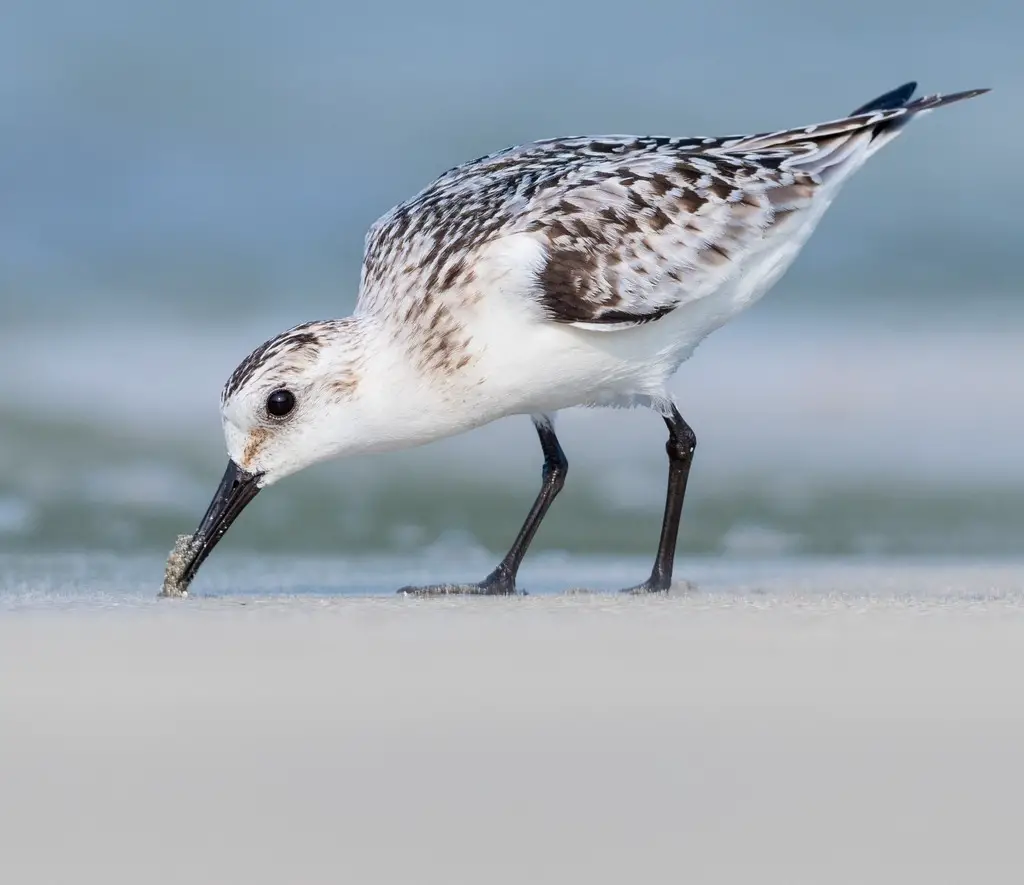
The Sanderling is a small, pale shorebird measuring about 7 to 8 inches (18 to 20 cm) in length with a wingspan of 16 to 18 inches (41 to 46 cm). It has a stout body, short neck, and a straight black bill. In breeding plumage, Sanderlings display mottled gray and white feathers, while in winter they appear mostly white with some gray. Their black legs and quick movements make them easy to spot along sandy beaches.
Sanderlings are known for their energetic foraging behavior, running rapidly along shorelines following waves to pick up small invertebrates exposed by retreating water. Their call is a sharp, high-pitched “chip” or “pit” sound. These birds are highly migratory, traveling thousands of miles between Arctic breeding grounds and temperate or tropical coastal wintering sites.
In Massachusetts, Sanderlings are commonly seen during migration and winter along sandy beaches, especially on Cape Cod and other coastal areas. They prefer open, flat beaches with tidal flats where they can forage efficiently. Their presence is a highlight for bird watchers during fall and spring migration seasons.
Piping Plover (Protected Species)
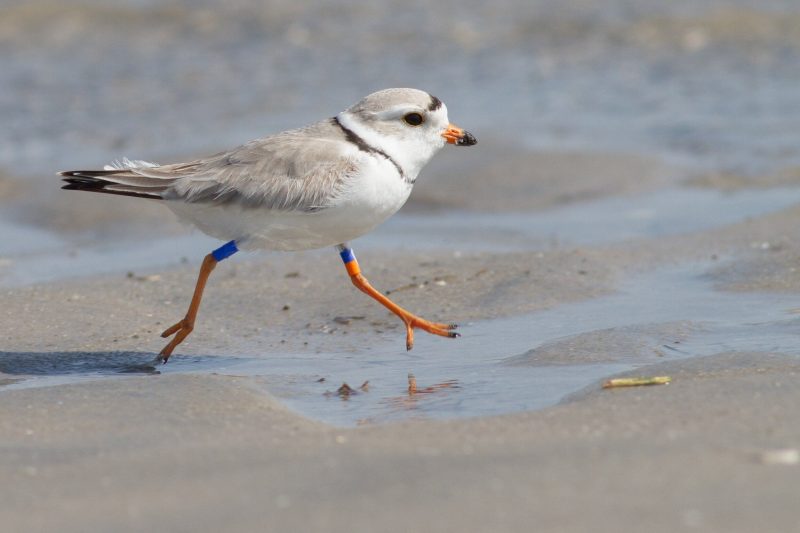
The Piping Plover is a small, pale shorebird measuring about 6 to 7 inches (15 to 18 cm) in length with a wingspan of 14 to 16 inches (35 to 41 cm). It has sandy-colored upperparts that blend into beach environments, a white belly, and distinctive black bands across the forehead and neck during breeding season. Its short orange bill and legs add to its unique appearance.
Piping Plovers produce soft, high-pitched whistles and piping calls used to communicate in nesting areas. They are ground-nesters, laying camouflaged eggs in shallow scrapes on sandy beaches or dunes. Their behavior includes vigilant guarding of nests and distraction displays to protect chicks from predators. Due to habitat loss and human disturbance, Piping Plovers are federally protected and subject to intensive conservation efforts.
In Massachusetts, Piping Plovers breed on select sandy beaches along the coast, including Cape Cod and barrier islands. Their populations are monitored closely, with restricted access to nesting sites during breeding season from late spring to early summer. Their protection is a priority to ensure the survival of this vulnerable species in the state.
Black Skimmer

The Black Skimmer is a distinctive coastal bird measuring about 15 to 17 inches (38 to 43 cm) in length with a wingspan of 39 to 42 inches (99 to 107 cm). It has black upperparts, white underparts, and a unique bill with a longer lower mandible used for skimming the water surface while flying. Its bright orange and black bill and red legs make it highly recognizable.
Black Skimmers produce a variety of harsh and chattering calls often heard near their colonies. Their feeding behavior is remarkable; they fly low over calm waters at dusk or dawn, skimming their lower mandible through the water to catch small fish and crustaceans. They nest in loose colonies on sandy beaches or islands, often alongside terns and gulls.
In Massachusetts, Black Skimmers are rare and primarily seen during summer along coastal beaches and estuaries. Their nesting sites are sensitive and sometimes protected due to disturbance risks. Bird watchers cherish sightings of this unusual and elegant seabird during warm months along the coast.
Common Eider
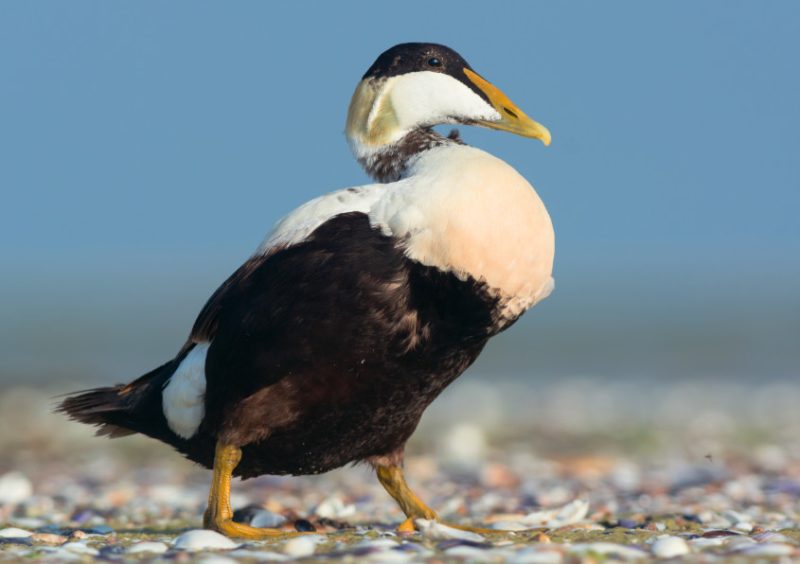
The Common Eider is a large sea duck measuring about 21 to 28 inches (54 to 71 cm) in length with a wingspan of 39 to 43 inches (99 to 110 cm). Males have striking black and white plumage with a distinctive greenish patch on the neck, while females are mottled brown for camouflage. They have large, bulky bodies and a sloping forehead with a strong, flattened bill adapted for diving.
Common Eiders produce low, croaking calls and grunts, especially during the breeding season in colonies. They are expert divers, feeding primarily on mollusks and crustaceans found on the ocean floor. Eiders often form dense breeding colonies on rocky islands and coastal shores, showing strong site fidelity year after year.
In Massachusetts, Common Eiders are mostly found along offshore islands, rocky coasts, and bays during winter and migration. They breed primarily in northern New England but can occasionally be seen during migration in the state’s coastal waters. Their populations are closely monitored due to environmental changes affecting their marine habitats.
Downy Woodpecker
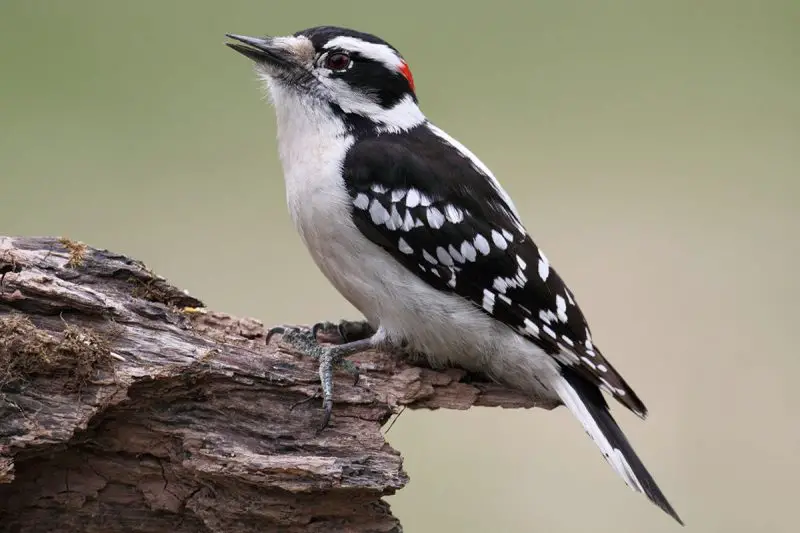
The Downy Woodpecker is the smallest woodpecker in Massachusetts, measuring about 5.5 to 6.7 inches (14 to 17 cm) in length with a wingspan of 9.8 to 11.8 inches (25 to 30 cm). It has a white belly and back with black wings that are spotted with white. The male sports a small red patch on the back of the head, while the female lacks this marking. Its short bill is proportionate to its size, which helps distinguish it from similar species.
Downy Woodpeckers produce a sharp, rapid “pik” or “pik-pik” call and often drum rhythmically on tree trunks and branches to communicate territory or attract mates. They forage by pecking at tree bark to extract insects, particularly ants and beetle larvae. Their behavior includes acrobatic movements on branches and trunks, often seen in wooded areas and backyard feeders.
In Massachusetts, Downy Woodpeckers are common year-round residents found in deciduous forests, mixed woodlands, parks, and suburban areas. They adapt well to various habitats, including urban environments, and are frequently spotted at suet feeders. Their presence is a favorite among bird watchers due to their distinctive drumming and lively activity.
Hairy Woodpecker
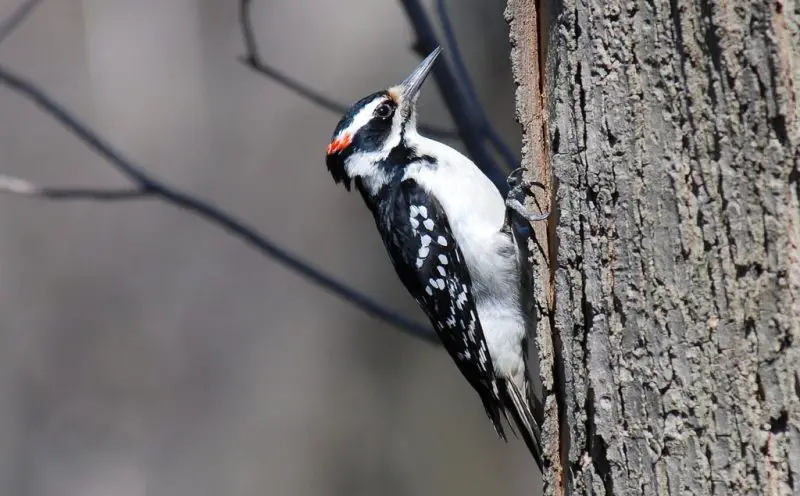
The Hairy Woodpecker is similar in appearance to the Downy but larger, measuring about 9 to 10 inches (23 to 26 cm) long with a wingspan of 14.2 to 17.3 inches (36 to 44 cm). It has a longer, more robust bill compared to the Downy, which is a key identification feature. Its plumage is black and white with a white underside and back, black wings with white spots, and a red patch on the back of the male’s head.
Hairy Woodpeckers emit a sharp, loud “peek” call and drum loudly on dead branches or utility poles. They feed primarily on insects found in tree bark, such as wood-boring beetles and larvae, using their strong bill to drill deep into wood. Their behavior is less acrobatic than the Downy but still involves climbing vertically along trunks and branches.
In Massachusetts, Hairy Woodpeckers are common year-round, preferring mature forests and wooded suburban areas. They coexist with Downy Woodpeckers but are more often found in larger woodlands. They play a vital role in controlling insect populations and contribute to the health of forest ecosystems.
Northern Flicker
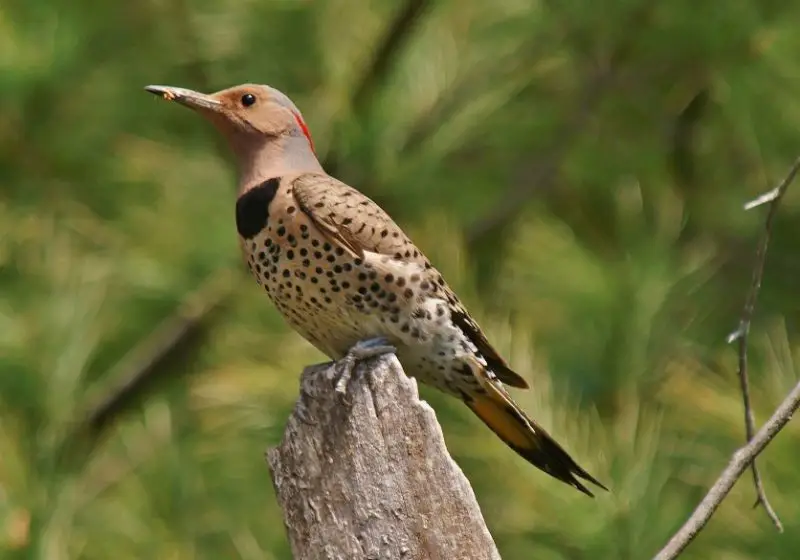
The Northern Flicker is a medium-sized woodpecker measuring 11 to 12 inches (28 to 31 cm) in length with a wingspan of 16 to 20 inches (41 to 51 cm). It has a brownish body with black spots on the belly and a barred back. Unlike most woodpeckers, Flickers often feed on the ground, searching for ants and beetles. Males have a distinctive red or black mustache stripe depending on the region.
Their call is a loud, repetitive “wick-a-wick-a-wick” and they also produce a sharp, ringing “kleeer” or “kleeer-kleeer” sound. Flickers drum loudly and frequently on metal objects and trees. Behaviorally, they forage both on the ground and in trees, using their long, curved bill to dig into soil or peck wood. They are known for their distinctive, fluttering flight.
In Massachusetts, Northern Flickers are year-round residents found in open woodlands, forest edges, parks, and suburban areas. They prefer habitats with scattered trees and open ground. Their unique feeding habits and colorful markings make them a favorite among bird enthusiasts in the state.
Red-bellied Woodpecker

The Red-bellied Woodpecker is a medium-sized woodpecker measuring about 9 to 10 inches (23 to 25 cm) long with a wingspan of 13 to 16 inches (33 to 41 cm). It has striking black and white barred patterns on its back and wings, a pale face, and a faint reddish wash on the belly. Males feature a bright red cap extending from the bill to the back of the neck, while females have red only on the nape.
This woodpecker produces a loud, rolling “churr” call and a distinctive descending whistle. It forages by pecking on tree trunks and branches to find insects and also eats fruits and nuts. Its behavior includes storing food in tree crevices and aggressively defending feeding territories. The Red-bellied Woodpecker is active and often seen clinging to vertical surfaces.
In Massachusetts, Red-bellied Woodpeckers are common year-round, especially in mature deciduous forests, suburban woodlands, and parks. Their range has expanded northward in recent decades, and they are now a familiar and conspicuous species in many areas of the state.
Pileated Woodpecker

The Pileated Woodpecker is the largest woodpecker in Massachusetts, measuring about 16.5 to 19 inches (42 to 48 cm) long with a wingspan of 26 to 30 inches (66 to 76 cm). It is easily identified by its striking black body, white underwings, and large red crest on its head. The bird has a long, chisel-like bill used for excavating large rectangular holes in trees to find carpenter ants and other insects.
Pileated Woodpeckers produce a loud, ringing call often described as a series of “kuk-kuk-kuk” notes, and their drumming is deep and resonant. Their behavior includes powerful, deliberate pecking and hammering on dead or dying trees to access insect tunnels. They are shy but can be heard and sometimes seen in mature forests.
In Massachusetts, Pileated Woodpeckers are year-round residents found in large tracts of mature hardwood or mixed forests. They require substantial tree cover for nesting and foraging and are considered a species indicative of healthy forest ecosystems. Their large size and distinctive calls make them a memorable sight for bird watchers.
Wild Turkey
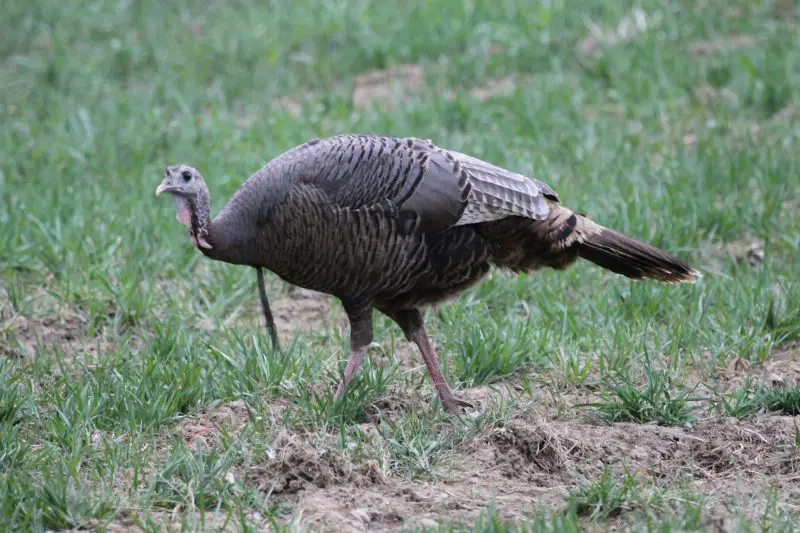
The Wild Turkey is a large, ground-dwelling bird measuring about 36 to 48 inches (91 to 122 cm) in length with a wingspan of 49 to 63 inches (124 to 160 cm). Males, called toms, have iridescent bronze and greenish plumage with a distinctive fan-shaped tail and a bare, red, and blue head. Females are smaller and duller with mottled brown feathers. Wild Turkeys are strong runners and capable of short flights.
Their vocalizations include gobbles, clucks, and purrs, with the male’s gobble being loud and far-carrying, especially during the breeding season. Behaviorally, Wild Turkeys forage on the ground for seeds, nuts, insects, and small amphibians, often in forests, fields, and wetlands. They are social birds, forming flocks outside the breeding season, and use elaborate courtship displays in spring.
In Massachusetts, Wild Turkeys are common year-round residents inhabiting mixed hardwood forests, agricultural areas, and suburban woodlands. Once extirpated, their populations have rebounded due to reintroduction and habitat management programs. They are now widespread and frequently observed by wildlife enthusiasts.
Ruffed Grouse
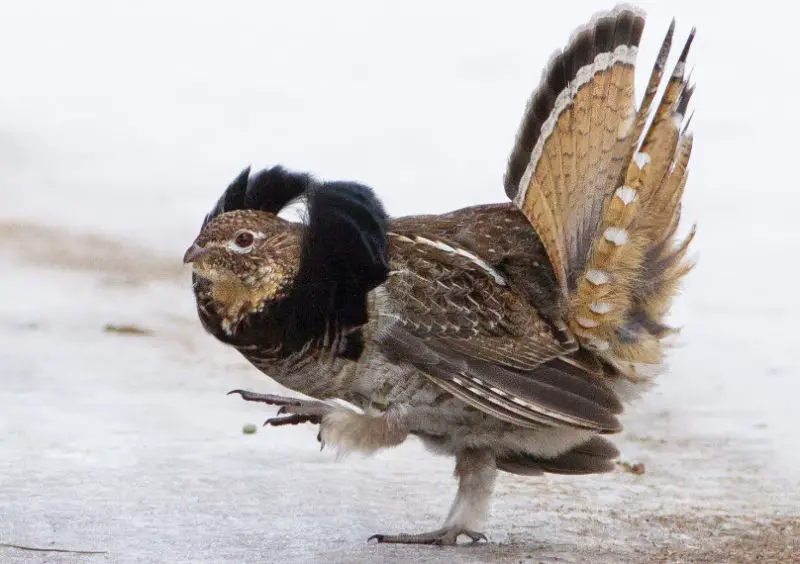
The Ruffed Grouse is a medium-sized game bird about 16 to 19 inches (40 to 48 cm) long with a wingspan of 22 to 24 inches (56 to 61 cm). It has mottled brown, gray, and black plumage that provides excellent camouflage in forest undergrowth. The species is named for the ruff of feathers around the neck, which males display during courtship.
Its calls include a distinctive drumming sound produced by rapidly beating wings during the breeding season, used to attract females and mark territory. Ruffed Grouse are ground feeders, eating buds, leaves, insects, and berries. They prefer dense deciduous or mixed forests with thick understory and often create shallow nests on the forest floor.
In Massachusetts, Ruffed Grouse are year-round residents primarily in forested areas, especially in northern and western parts of the state. They favor young forests with dense shrubs and are important game birds managed for hunting. Their populations fluctuate with habitat conditions and predator presence.
American Woodcock

The American Woodcock is a small, plump shorebird about 10 to 12 inches (25 to 30 cm) long with a wingspan of 16 to 18 inches (41 to 46 cm). It has mottled brown, black, and gray plumage that provides excellent camouflage on the forest floor. Its long, straight bill is adapted for probing soil for earthworms, its primary diet.
Woodcocks produce distinctive nasal “peent” calls and perform an aerial courtship display involving spiraling flights and twittering sounds during dusk in spring. They are crepuscular, most active at dawn and dusk, foraging in moist, young forests and shrublands. Their behavior includes a unique zigzag walking pattern and sudden flights when flushed.
In Massachusetts, American Woodcocks are migratory breeders found in early successional forests, wetlands, and brushy areas during spring and summer. They migrate south for the winter but return each year to traditional breeding grounds. Their mysterious courtship displays make them a fascinating species to observe in the state.
Scarlet Tanager
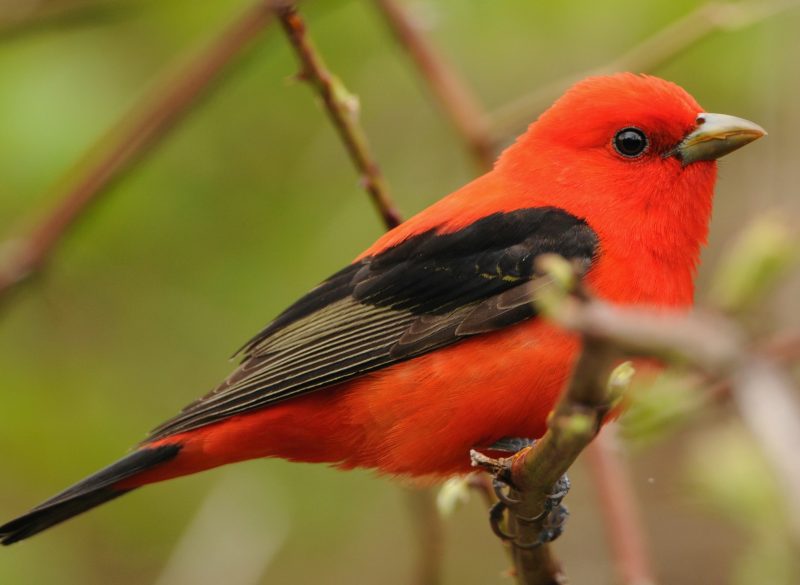
The Scarlet Tanager is a medium-sized songbird measuring about 6.3 to 7.1 inches (16 to 18 cm) in length with a wingspan of 9.8 to 11.8 inches (25 to 30 cm). Males are famous for their vibrant red bodies contrasted with jet-black wings and tail, while females display olive-yellow plumage. The bright coloration of the male makes it one of the most striking birds during the breeding season.
Their song is a series of short, burry whistles, often described as “pir-r-r-r, cher-wit, cher-wit.” Scarlet Tanagers forage high in deciduous forests, feeding mainly on insects such as caterpillars, beetles, and wasps, as well as some fruit. They are shy and often elusive, preferring the canopy where they sing and nest.
In Massachusetts, Scarlet Tanagers breed during the summer in mature deciduous and mixed forests, primarily in western and central parts of the state. They migrate to tropical South America for the winter. Their bright colors and melodious song make them a favorite among bird watchers during the warm months.
Rose-breasted Grosbeak
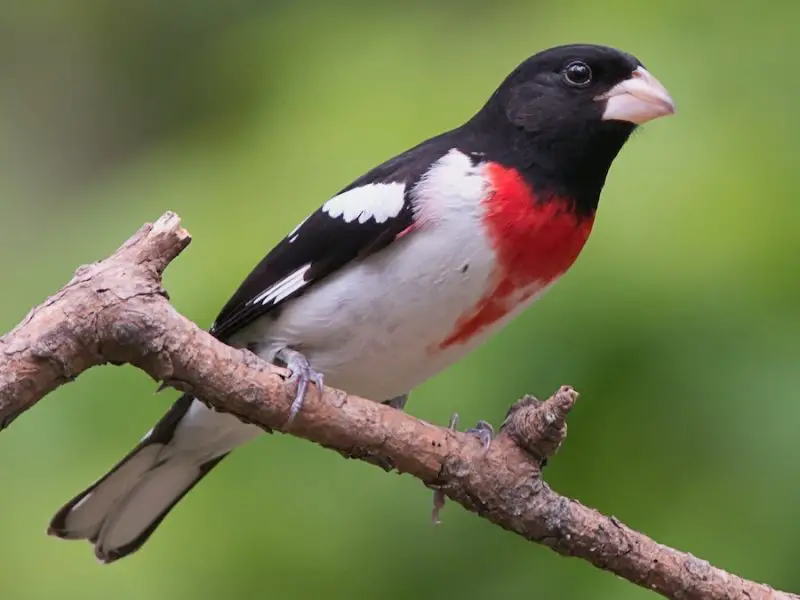
The Rose-breasted Grosbeak is a medium-sized songbird about 7 to 8 inches (18 to 20 cm) long with a wingspan of approximately 12 inches (30 cm). Males have a striking black and white plumage with a bright rose-red patch on the breast, while females are brown-streaked with a buffy eyebrow stripe. Their thick, conical bill is adapted for cracking seeds and eating fruit.
These grosbeaks produce a rich, melodious song reminiscent of an American Robin but more musical and varied. They feed on insects, seeds, and berries, often visiting backyard feeders. Their behavior includes active foraging in shrubs and trees and singing prominently during the breeding season.
In Massachusetts, Rose-breasted Grosbeaks breed in deciduous and mixed forests, often near water and woodland edges. They arrive in late spring and depart by early fall to winter in Central and South America. Their striking appearance and pleasant song make them a sought-after species for bird enthusiasts.
Indigo Bunting
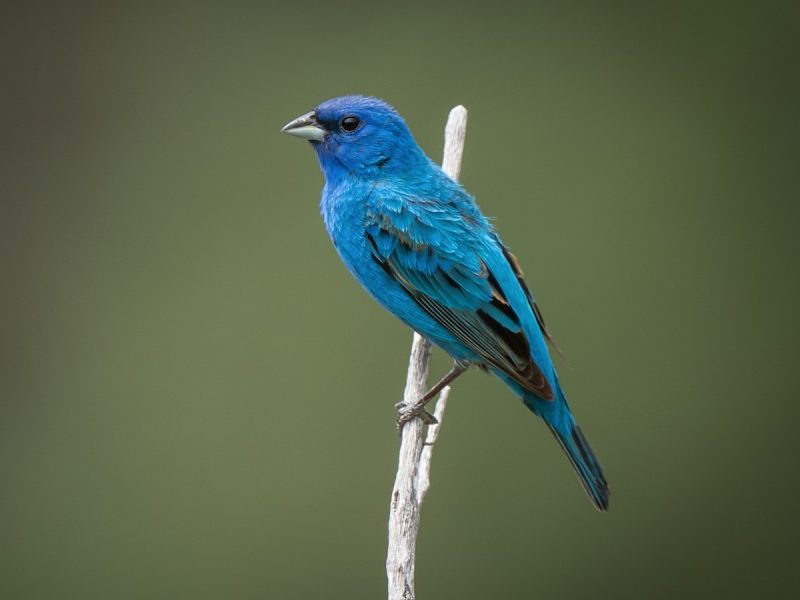
The Indigo Bunting is a small songbird about 4.5 to 5 inches (11 to 13 cm) in length with a wingspan of 7.5 to 9.8 inches (19 to 25 cm). Males display vibrant, iridescent blue plumage all over, while females are brown with faint blue tinges. Their bright blue feathers shimmer in sunlight, making them easy to spot during the breeding season.
Their song consists of high-pitched, musical warbles and trills used for territory defense and attracting mates. Indigo Buntings forage primarily on seeds, berries, and insects in shrubby habitats and forest edges. They are often found perched conspicuously on bushes or power lines, singing loudly.
In Massachusetts, Indigo Buntings breed in shrubby fields, forest edges, and open woodlands during the summer. They migrate to southern Florida and Central America for the winter. Their vivid coloration and sweet song make them a favorite among spring and summer bird watchers.
Various Flycatchers and Vireos

Flycatchers and vireos are small to medium-sized songbirds common in Massachusetts, each with distinct calls and behaviors. Flycatchers, such as the Eastern Phoebe and Great Crested Flycatcher, have slender bills with bristles and catch insects mid-air with agile flight. Vireos, like the Red-eyed Vireo, are small, often olive-green birds with relatively plain plumage and a persistent, repetitive song.
Flycatchers produce sharp “chip” calls and complex songs, often flicking their wings and tails while perching. Vireos have slow, deliberate songs, with Red-eyed Vireos known for their nearly continuous singing during the breeding season. Both groups forage actively among leaves and branches, gleaning insects or sometimes eating berries.
In Massachusetts, these birds breed in forests, woodlands, and suburban areas during spring and summer. They migrate south for winter and are integral components of the state’s summer songbird community. Their diversity and behaviors add richness to birding experiences.
Snow Bunting
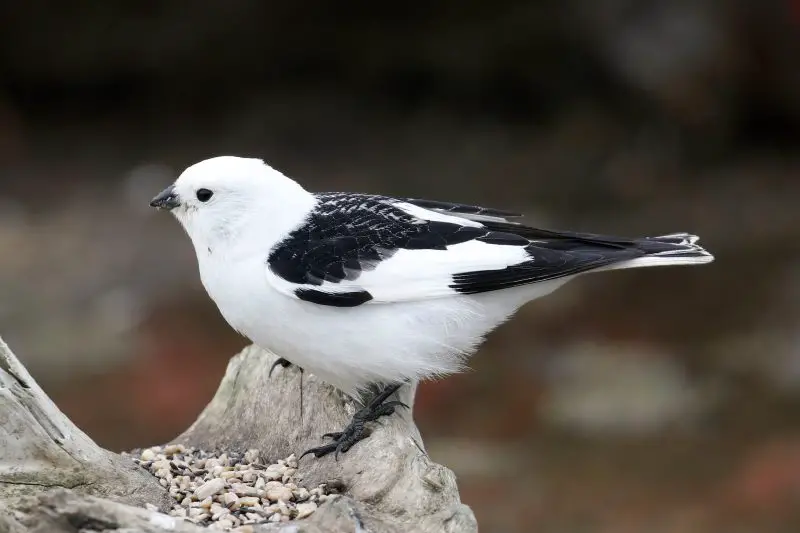
The Snow Bunting is a small, sturdy songbird about 6.3 to 7.5 inches (16 to 19 cm) long with a wingspan of 12.6 to 14.6 inches (32 to 37 cm). It has striking white plumage with black on the wings and back, which helps camouflage it in snowy environments. Males are whiter during the breeding season, while females show more brownish tones.
Snow Buntings produce short, musical calls and soft warbles, often heard in their tundra breeding grounds. They forage on seeds and insects on open ground, often in flocks during migration and winter. Their behavior includes ground feeding in open fields and beaches, where they use their strong legs to hop and scratch.
In Massachusetts, Snow Buntings are winter visitors, commonly found in coastal fields, beaches, and open farmland. They migrate from Arctic breeding grounds and are a favorite winter bird for observers seeking colorful northern species.
Lapland Longspur

The Lapland Longspur is a small sparrow-like bird about 6 to 6.7 inches (15 to 17 cm) long with a wingspan of 13 to 14 inches (33 to 36 cm). It has a streaked brown back, black face and throat during the breeding season, and white underparts. Females and non-breeding males are duller with less defined facial markings.
Their call is a soft “tsip” or “chip,” and their song includes buzzy trills. Lapland Longspurs forage on seeds and insects in open tundra and grassland habitats. They are ground feeders, often seen walking or running on snow or bare ground during migration.
In Massachusetts, Lapland Longspurs are rare to uncommon winter visitors, mainly found in coastal fields, beaches, and open agricultural lands. They migrate from Arctic breeding areas and are considered a special sighting by birders during cold months.

